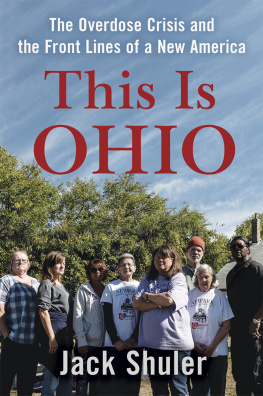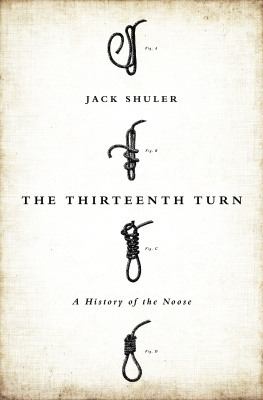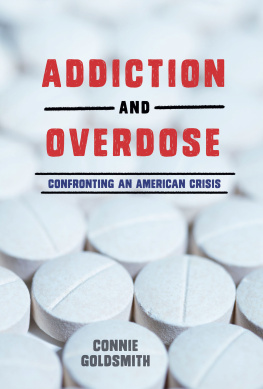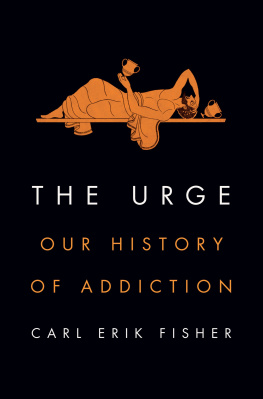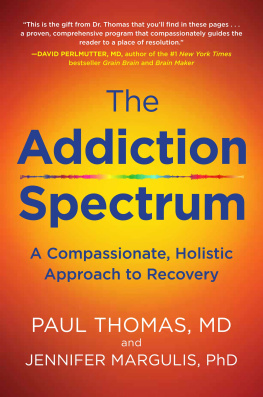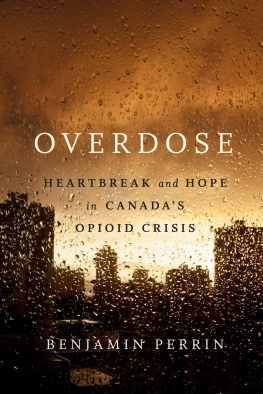Table of Contents
Guide

ALSO BY JACK SHULER
The Thirteenth Turn: A History of the Noose
Blood & Bone: Truth and Reconciliation in a Southern Town
Calling Out Liberty: The Stono Slave Rebellion and the Universal Struggle for Human Rights

This Is Ohio
Copyright 2020 by Jack Shuler
First hardcover edition: 2020
All rights reserved under International and Pan-American Copyright Conventions. No part of this book may be used or reproduced in any manner whatsoever without written permission from the publisher, except in the case of brief quotations embodied in critical articles and reviews.
Library of Congress Cataloging-in-Publication Data
Names: Shuler, Jack, author.
Title: This is Ohio : the overdose crisis and the front lines of a new America / Jack Shuler.
Description: First hardcover edition. | Berkeley, California : Counterpoint, 2020.
Identifiers: LCCN 2019058614 | ISBN 9781640093553 (hardcover) | ISBN 9781640093560 (ebook)
Subjects: LCSH: Opioid abuseOhio.
Classification: LCC RC568.O45 S525 2020 | DDC 362.29/309771dc23
LC record available at https://lccn.loc.gov/2019058614
Jacket design by Jaya Miceli
Jacket photograph by Doug Swift
Book design by Jordan Koluch
COUNTERPOINT
2560 Ninth Street, Suite 318
Berkeley, CA 94710
www.counterpointpress.com
Printed in the United States of America
10987654321
TO THE ONES WHO KEEP SHOWING UP
The axe doesnt have to have the last word. We have the last word.
CLIFF HOUSTON
P lease note that I have changed or not disclosed the names of some people mentioned in this book to protect their identities and their privacy. I have obscured some locations for this purpose as well. I recognize that this is a story of a small piece of the social services landscape in central Ohio. There are other organizations and people working to combat the overdose crisis who are not mentioned and who do not always get the light they deserve. My intention in this book is to show how a group of people in one placepeople who have often been absent from our public conversations about this ongoing tragedyhave experienced the overdose crisis. I have also provided extensive research and resources in the endnotes, especially concerning the drug war and substance use disorder. I urge readers to take advantage of them.
Finally, I have tried to use person-first language when writing. In dialogue in which people are speaking to one another or to me, I stayed true to the language they used. Person-first language is an important intervention for combating the stigma associated with substance use disorder. Health in Justice at the Northeastern University School of Law has produced an excellent resource called Changing the Narrative (changingthenarrative.news) not only for understanding person-first language but also for addressing some of the inaccuracies in reporting and public perception of drug use and the overdose crisis. I admit that in the past I failed on this point on many occasions in my own writing, and I am now appreciative of the people who created this resource.
E arly August 2019. A busy summer morning in a grassy corner lot at East Main and Buena Vista Streets in Newark, Ohio, a small city about forty-five minutes east of Columbus and the county seat of Licking County, named after the river and the salt licks that once attracted deer and buffalo to the area. Storms rolled through last week, and the worst of the summer heat has been kept at bay. Today: low humidity, blue sky with scraps of clouds wandering through. A tent is set up in the shade of a sprawling mulberry tree; a scrawny hackberry and a silver maple linger just behind. Some folks call these trash trees, but they are resilient wonders, pushing up through hardscrabble urban dirt and concrete, willing themselves into existence.
These trees give ample respite to the unsheltered who gather at this corner, where a group of mostly women have set up this tent every Saturday for about a year and a half now. The group members offer foodalways hot dogs, sometimes fried bologna sandwiches, chips, cookies, fruit when availableand clothing, which hangs on portable racks, lies folded neatly on tables, or is stuffed helter-skelter in bags below. They also offer brown paper bagsharm-reduction kitscontaining sterile syringes and the drug naloxone (also known by its trade name Narcan), used to reverse opioid overdoses.
Every Saturday, between seventy-five and one hundred people who are homeless and underserved in this community come to this empty corner lot, which muds up in the spring and is now overgrown with crabgrass and knee-high weeds in the corners. The group under the tent is Newark Homeless Outreach, the brainchild of Trish Perry and Jen Kanagy, two fiercely independent and engaged women who saw a gap and raced to fill it. Jen is a nurse by trade, and Trish works as a transportation manager at one of the many local distribution centers, though her real passion is advocating for people with substance use disorder. Every Saturday theyre here at the corner, despite the vagaries of Ohio weather.
The corner also attracts many local grassroots activists and organizers. People like Eric Lee, an activist and addiction recovery advocate who drops in sometimes to connect with friends and help people who, like him, have served time and are trying to navigate reentry from prison or jail; Chris Gargus, a deeply religious organizer for an abstinence-based addiction treatment group called the Champions Network; and Tresa Jewell, a former nurse who served in a mobile army surgical hospital (MASH) in Vietnam and who now runs a small nonprofit called Johns Helping Hands and delivers food to people who are homeless and living in camps around central Ohio.
Most men and women and some children, the towns nomadic poor, come here by foot or bicycle. Most are white, like 92 percent of Newark and like Trish and most of the folks who serve them, though some are not. In the summer, some are shirtless or in jeans and cutoff T-shirts, weighed down with backpacks and shopping bags. Some are people who use drugs. Some have mental health issues. Some have been convicted of felonies. Some work minimum-wage jobs and struggle to raise their children. And some are just wandering. They are hungry or food insecure. They are unhoused or underhoused. And, in most places, they feel unwelcome.
A dozen people walk around the tables picking up donated snacks or riffling through stacks of used clothes, boxes of shoes, and a bin full of ziplock bags jammed with basic toiletries. Volunteers mostly stand back; they help people when needed, but they rarely limit folks, as theres enough to go around. Someone grabbing three sandwiches instead of one probably needs them or plans on sharing.
Today a bungee cord on the coolers keeps people from dipping their hands in. There has been a rise in hepatitis A cases, and intravenous drug users are a particularly vulnerable populationthe health department will be here next week to give hep A vaccinations.
Many folks seem down, the bad mood raw and palpable. Peggy Rutons son was just sent to prison for two years, and Trishs son Billy McCall has just been sentenced to eleven months because of a probation violation. And there are rumors of an uptick in overdoses. But the work must go on.
Next page
